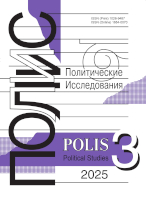Arab Spring as a Global Phase Transition Trigger
Korotayev A.V.,
Dr. Sci. (Philos.), Dr. Sci. (Hist.), Professor, Head of Centre for Stability and Risk Analysis, HSE University; Senior Research Fellow, RUDN University; Professor of the Faculty of Global Studies, M.V. Lomonosov Moscow State University, akorotayev@gmail.com
elibrary_id: 72980 | ORCID: 0000-0003-3014-2037 | RESEARCHER_ID: N-1160-2018
Shishkina A.R.,
Master of Political Science, Junior Researcher, Socio-Political Destabilization Risk Monitoring Laboratory, National Research University Higher School of Economics; Junior Researcher, Center for Civilizational and Regional Studies, Institute for African Studies, Russian Academy of Sciences, alias.shishkina@gmail.com
elibrary_id: 781188 |
Isayev L.M.,
Cand. Sci. (Pol. Sci.), Vice-Head of the Laboratory for the Monitoring of Sociopolitical Destabilization Risks, National Research University Higher School of Economics, Moscow, Russia, isleonid@yandex.ru
elibrary_id: 642938 |
DOI: 10.17976/jpps/2016.03.09
Korotayev A.V., Shishkina A.R., Isayev L.M. Arab Spring as a Global Phase Transition Trigger – Polis. Political Studies. 2016. No. 3. https://doi.org/10.17976/jpps/2016.03.09
There are grounds to assume that in 2011–2012 the World System experienced to some extent a phase transition to a qualitatively new state of global protest activity. This phase transition is shown to bear some resemblance to the one which the World System experienced in the early 1960s. The first (after 1919) phase transition of this sort occurred in the early 1960s and was related to the growth of global informational connectivity after the World War II, as well as the improvement of the means of protest self-organization due to the spread of television, portable radio receivers, portable electric loud-speakers and other technologies of the Fourth Kondratieff Cycle. The phase transition of the early 2010s was prepared by a new wave of growth of global informational connectivity, as well as the improvement of the means of protest self-organization due to the spread of various technologies of the Fifth Kondratieff cycle (the Internet, satellite television, Twitter and other social networks, mobile telephony etc.). Similarly to what was observed during the Fourth Kondratieff Wave, during the Fifth Cycle while the spread of these technologies was going on for many years before 2011, their internal colossal potential for generating and spreading protest activity was realized in one leap.
See also:
Akayev A.A.,
«A Mathematical Model Should Be Good Help for Politicians…». – Polis. Political Studies. 2009. No3
Umov V.I.,
Afterword to a Forecast: the Kondratiev Cycles and Russia. – Polis. Political Studies. 1994. No2
Umov V.I., Lapkin V.V.,
Kondratieff Cycles and Russia: Prognosis of Reforms .. – Polis. Political Studies. 1992. No4
Semenenko I.S.,
Evolutionary cycles and problems of forecasting political changes. – Polis. Political Studies. 2015. No1
Korotayev A.V., Shishkina A.R., Lukhmanova Z.T.,
The Global Socio-Political Destabilization Wave of 2011 and the Following Years: A Quantitative Analysis. – Polis. Political Studies. 2017. No6





.jpg)






 print
print
.jpg)
.jpg)